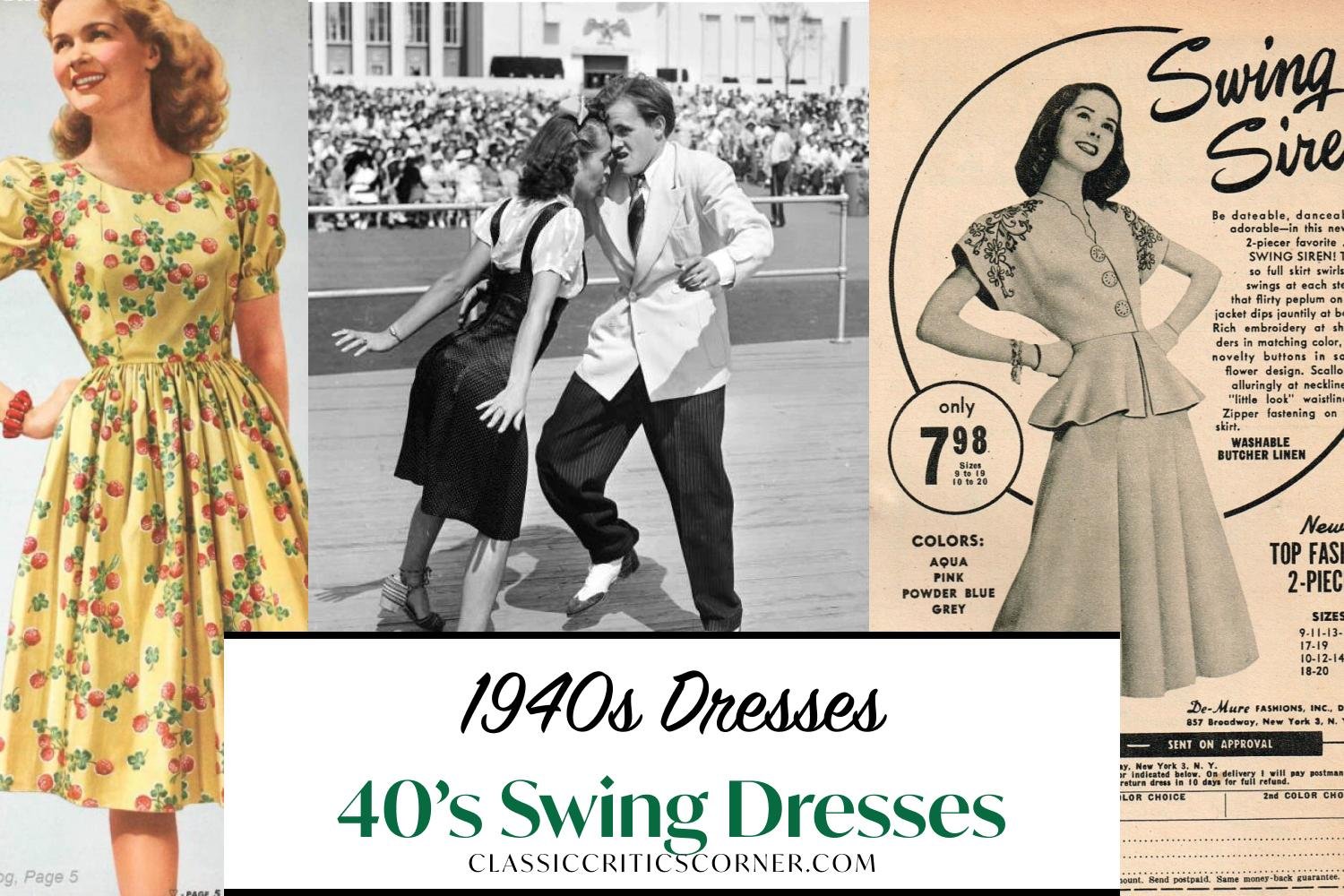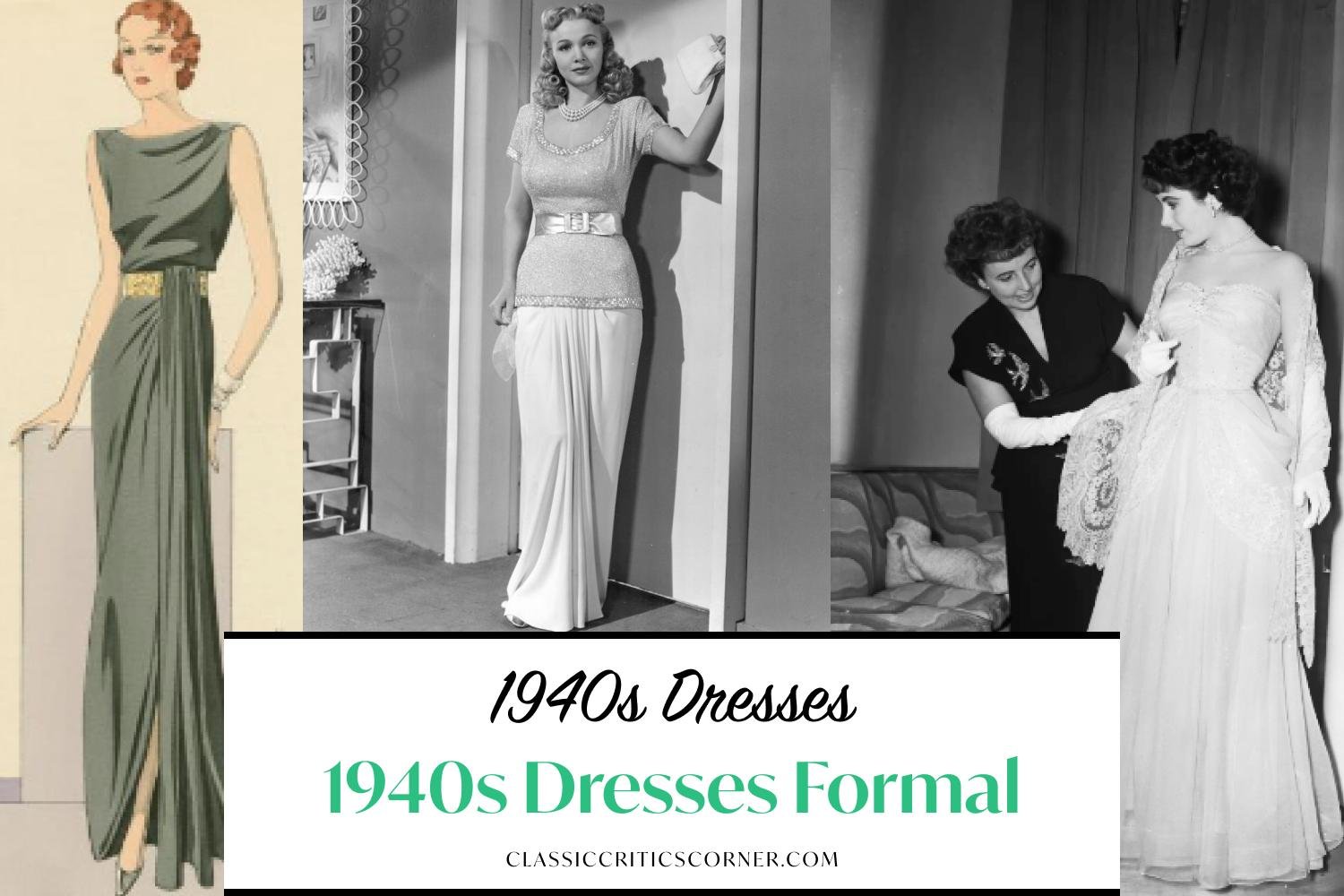The Ultimate Guide to Vintage Style 1940s Dresses
This post may contain affiliate links
An overview of 1940s dresses including the casual shirt waist dress, formal dresses, and pin up dresses with examples worn by 1940s fashion icons.
This post is all about Vintage Style 1940s Dresses
This is an overview of our 1940s Dresses series.
“Fashion changes, but style endures.”
What a perfect description for 1940s dresses!
This influential decade produced some of the most iconic and timeless dress styles that we still love to this day.
There were a range of popular dress styles in 1940s.
The 1940s dress styles were influenced by a number of factors, including the fashion of the proceeding decade (yes, the 30’s), World War II, which beckoned in new needs and challenges (i.e. practical dresses for women joining the workforce in mass and fabric shortages!), and the Paris fashion scene (Christian Dior’s New Look), which was unveiled near the end of the decade, post the World War.
Hollywood also had a major influence on 1940s fashion.
One popular pattern company had the ingenious business idea to sell patterns recreating glamorous and famous styles.
These patterns were mirror outfits worn by famous fashion icons (like Betty Grable, or Katherine Hepburn) and outfits in popular movies (Casablanca anyone?).
Today we will explore an overview of the unique style elements of 1940s including casual dresses, swing dresses, summer dresses, tea dresses, cocktail dresses, formal dresses, pin up dresses, and plus-size dresses.
We will also peek behind the scenes at candid shots capturing the everyday 1940s dresses for the women and girls, as well as get a behind the scenes scoop on 1940s fashion from the iconic Old Hollywood Glamour stars including Lauren Bacall, Ingrid Bergman, Rita Hayworth, Gene Tierney, Betty Grable, Lucille Ball, and Linda Darnell.
1940s Vintage Dresses Style Elements
The early 1940s fashion in the United States was heavily influenced by World War II.
Some of the early to mid 40’s fashion was subdued with all of the attention on the war.
Not only did women’s dresses have to be practical, as women entered the workforce in droves to help support their families and their country, but also clothing was rationed for many in Europe.
This limited how many articles of clothing women were allowed to buy each year.
Plus there were strict guidelines limiting how much fabric could be used in each dress and what type of fabric was allowed.
So say hello to shorter hem lines for 1940s dresses (vs 1930s dresses) that hit just delightfully just below the knee.
Practical menswear also had a large influence on 1940s fashion.
The classic button-up shirt dress (or house dress) became a staple in the early years of the decade.
Alot of variations of a simple a line dress with shoulder pads were also popular.
After World War II, the Paris fashion scene revived, with Christian Dior’s fashion debut of the ‘New Look’, which took the world by storm.
Above, Christian Dior’s New Look which gave a preview of 1950s fashion
Once again change was in the air for 1940s dress styles.
Say goodbye to the boxy padded shoulders and knee length hemlines, and say hello to the softy rounded shoulders, narrow waists, and mid-calf hemlines with a wide flared hem (think lots of swirl).
The giddy designers happily used more fabric, since fabric rations from the war were lifted.
1940s Style Dresses Silhouettes & Necklines
What was the most common silhouette for 1940s dresses?
The most popular silhouette for the 1940s dresses was a-line, but others include the sheath and ballgown styles.
Shoulder pads were also very popular in the 1940s (especially early and mid 1940s) as they helped achieve the popular military inspired square-shouldered look of the early to mid 1940s.
In the later 1940s, a more feminine hourglass figure was emphasized with a fitted waist and fuller skirts.
What were popular dress lengths for 1940s?
Most everyday 1940s dresses were knee length.
In the later 1940s dress hemlines dropped to mid-calf inspired by Christian Dior’s New Look.
Also, throughout the decade, it was popular for cocktail and evening gowns to be floor length.
What did women wear with 1940s dresses?
Belts - Say yes to the belt! These emphasized the waist, popular throughout the decade.
Accessories, accessories, and accessories - Vintage shoes, back-seamed stockings, hair accessories, bangles, necklaces, earrings, gloves, headscarves, sunglasses, and furs were all in a 1940s ladies arsenal.
To dress up, or to dress down... that was the question.
1940s dresses also hd high necklines and low hemlines compared to today.
“Even the most beautiful legs - Marlene Dietrich’s, for instance - look better when the kneecap is covered.”
Casual Dresses in the 1940s
In the 1940s, the a common casual dress was the 1940s house dress.
It's design was streamlined for no-nonsense dressing and work, including even placing the buttons in the front to allow to someone to get ready without help.
For more examples and fashion icons read:
1940s Swing Dress
With the rise in popularity of dancing including the swing and the rumba, a dress was needed to allow for all that movemen.
Enter the 1940s swing dress.
The swing dress was a 1940s dress with fuller skirt and looser arms to allow for more movement during dancing, i.e. a party dress.
For more examples and fashion icons read:
1940s Summer Dress
Warmer weather required light fabric and shorter sleeves.
1940s summer dresses came in a variety of styles including sailor dresses, border print dresses, peasant dresses, apron pinafore dresses, wrap dresses, peplum dresses, and more.
For more examples and fashion icons read:
1940s Tea Dress
What is a 1940s tea dress?
A 1940s tea dress is a dress with short sleeves and a full skirt, which usually falls elegantly just below the knees.
The fabric for tea dresses was typically colorful fabric (feminine floral prints and fun polkadots were fan favorites), but also delicate pastel colors were popular as well.
These dresses incorporated beautiful feminine details, like embroidered necklines, charming bows, puffed cap sleeves, and delightful frills.
Variations included the classic 1940s button down shirt dress which transforms into a 1940s tea dress with fancier fabrics and cute ornamental details.
The tea dress was one of the favorite dress styles in the 1940s because they were practical, comfy and so adorably chic and stylish.
Fun Fact!
Afternoon tea originated in the Victorian Era when ladies hosted tea informally in their house for friends, and because this was an informal social gathering, ladies did not need the full on crazy Victorian dresses and corsets, but rather a more informal dress--and thus the early version of the more informal tea dress was born.
1940s Cocktail Dress
The 1940s Cocktail dress was the going out dress.
An assortment of styles and design embellishments were popular.
For more examples and fashion icons read:
1940s Dresses Formal
Formal dresses in the 1940s had a delightful range from simple to ornate.
The glitz factor could be turned up with loads of sparkle or kept simple with a touch of fur.
Popular styles included grecian gowns and evening skirts and tops, and more.
For more examples and fashion icons read:
1940s Pin Up Dress
[Concerning her and other stars' status as World War II pin-up girls] “A lot of these kids don't have any women in their life to fight for - I guess what you would call us girls is kind of their inspiration. It is a grave responsibility.” --Betty Grable
1940s pinup dresses are so so fun and over the top sexy.
Talk about a style that looks gorgeous on all body types, with curvy women getting an automatic 10.
What makes a 1940s dress a pinup dress?
The 1940s pin up dresses were definitely more form fitting, had lower necklines, higher hemlines (hello legs!), were usually short sleeves, and were cut in a fun or colorful fabric.
Of course, when wearing a pin up dress a sexy pose was a must.
The ultra fitted pencil skirt pinup style was more of a 1950s trait, as you’ll notice that the 40s pinup dresses were more a-line (and thus flowy).
Betty Grable (right image) knew a thing or two when it came to being a pin-up girl, as she was the the top pin-up girl of World War II, even beating out Rita Hayworth! (center image)
Betty Grable’s bathing-suit poster made her the #1 pin-up girl!
What do you think of her 1940s pinup style dress outfit that she dones for this fun photo shoot?
Other posts you might like:
1940s Dresses Plus Size
Plus-size dresses in the 1940s utilized the same silhouettes.
Skilled designers took full advantage of fabric colors and lines to show off the curvier silhouette to the best advantage, and of course, all while using incorporating the fabulous 40’s design elements, such as the pointy dramatic shoulder pads, and higher necklines with different trendy shapes, such as the sweetheart neckline or shirred.
This section deserves an entire dedicated post, but we’ve rounded up a couple fabulous examples of 1940s plus size dresses, ranging from everyday household looks to dazzling old Hollywood Glamour styles.
The 1940s house dress or shirt dress was a favorite plus size style, (bottom left image) and it’s no wonder -- it’s universally flattering, comfy, and so practical, for whatever you need to tackle in the day.
We love how confident Mae West (center image) is in her stunning 1940s outfit.
“It’s better to be looked over than overlooked”
This post was all about Vintage Style 1940s Dresses
Other posts you might like:
11 Dazzling 1940s Vintage Style Wedding Dresses
Women’s 50s Fashion: Vintage 1950s Housewife Dresses
1940s Swimsuits - Welcome the Bikini and other Retro Bathing Suit Styles













